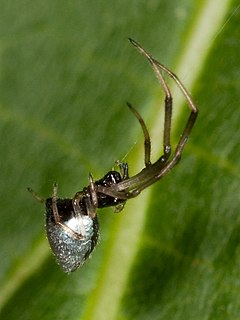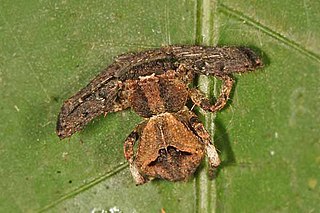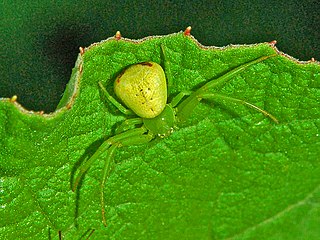
The Thomisidae are a family of spiders, including about 170 genera and over 2,100 species. The common name crab spider is often linked to species in this family, but is also applied loosely to many other families of spiders. Many members of this family are also known as flower spiders or flower crab spiders.

Misumena is a genus of crab spiders sometimes referred to as flower crab spiders. They are similar in appearance to several other genera in the family Thomisidae, such as Misumenoides and Mecaphesa.

Xysticus is a genus of ground crab spiders described by C. L. Koch in 1835, belonging to the order Araneae, family Thomisidae. The genus name is derived from the Ancient Greek root xyst, meaning "scraped, scraper".

Rhene is a spider genus of the family Salticidae.

Ozyptila is a genus of crab spiders that was first described by Eugène Louis Simon in 1864. It has been misspelled as "Oxyptila" in multiple accounts.

Argyrodes, also called dewdrop spiders, is a genus of comb-footed spiders that was first described by Eugène Louis Simon in 1864. They occur worldwide, and are best known for their kleptoparasitism. They can spin their own webs, but tend to invade and reside in their hosts' webs. This relationship can be commensal or even mutual if the dewdrop spider feeds on small trapped insects that are not eaten by the host. Some species can even prey upon the host.

Runcinia is a genus of crab spiders that was first described by Eugène Louis Simon in 1875. The former R. elongata is a synonym of Thomisus elongatus.

Thomisus is a genus of crab spiders with around 150 species described. The genus includes species that vary widely in their ecology, with some that ambush predators that feed on insects visiting flowers. Like several other genera in the family Thomisidae, they are sometimes referred to as flower crab spiders, from their crab-like motion and their way of holding their front legs, reminiscent of a crab spreading its claws as a threat.

Cyrtarachne is a genus of orb-weaver spiders first described by Tamerlan Thorell in 1868.

The genus Oxytate, commonly known as grass crab spiders, comprises a homogenous group of nocturnal crab spiders. The complete mitochondrial genome of the type species O. striatipes was determined in 2014.

Chilobrachys is a genus of Asian tarantulas that was first described by Ferdinand Anton Franz Karsch in 1892.
Epidius is a genus of crab spiders that was first described by Tamerlan Thorell in 1877. It is a senior synonym of Pothaeus.
Monaeses is a genus of crab spiders in the family Thomisidae, containing twenty seven species.

Angaeus is a genus of Asian crab spiders first described by Tamerlan Thorell in 1881. It is considered a senior synonym of Paraborboropactus.

Camaricus is a genus of crab spiders that was first described by Tamerlan Thorell in 1887.
Demogenes is a genus of crab spiders that was first described by Eugène Louis Simon in 1895.

Ebrechtella is a genus of crab spiders that was first described by Friedrich Dahl in 1907.
Loxobates is a genus of spiders in the family Thomisidae. It was first described in 1877 by Tamerlan Thorell. As of 2017, it contains 10 Asian species.
Massuria is a genus of spiders in the family Thomisidae. It was first described in 1887 by Tamerlan Thorell. As of 2017, it contains 8 Asian species.
Tharpyna is a genus of spiders in the family Thomisidae. It was first described in 1874 by L. Koch. As of 2017, it contains 12 species from Australia, India, and Indonesia.












